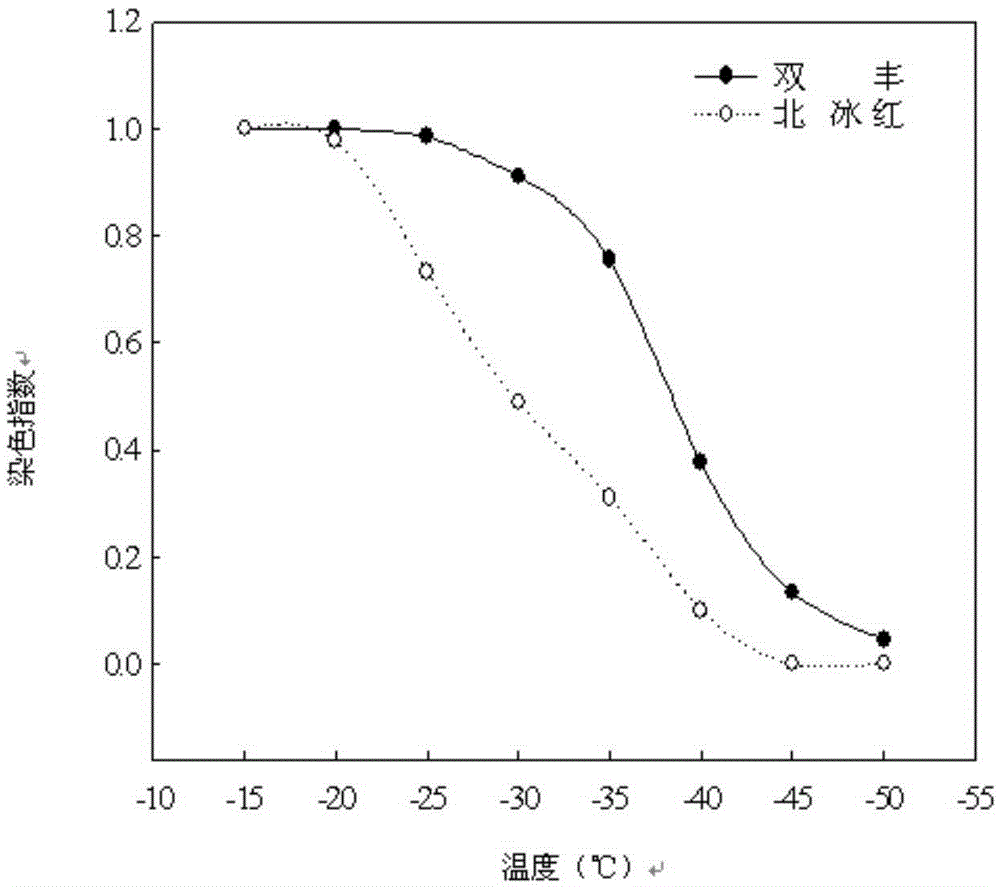Evaluation method of cold resistance of germplasm resources of Vitis amurensis in dormant period
An identification method, the technology of mountain grapes, applied in horticultural methods, botanical equipment and methods, seed and rhizome treatment, etc., can solve the problems of poor repeatability of measurement results, inaccurate identification results, etc., and achieve clear and gradable dyeing and grading boundaries. Coldness is simple and easy to operate, and the results are accurate and reliable
- Summary
- Abstract
- Description
- Claims
- Application Information
AI Technical Summary
Problems solved by technology
Method used
Image
Examples
Embodiment 1
[0048] The assay method of the dormancy period cold resistance of the grape germplasm resources provided by the present embodiment comprises the following steps:
[0049] Freezing treatment of mountain grape branches:
[0050] The grape branches of "Shuangfeng" as a germplasm resource were selected for freezing treatment. The grapevine branches in the dormant period of the germplasm resources were frozen at -25°C, -30°C, -35°C, -40°C, -45°C, and -50°C respectively. Place the vine branches at the above-mentioned 6 freezing temperatures for 10 hours, then raise the temperature to 20° C. and place them for 3 hours.
[0051] The dormant branches of Vitis vinifera were collected in mid-January from the dormant branches of the germplasm of the same maturity, cut into 20-25cm long branches, sealed with liquid paraffin, put into a sealed ziplock bag, and kept in a -15°C refrigerator save in .
[0052] Dyeing treatment of frozen branches:
[0053] Peel off the epidermis of the vine...
Embodiment 2
[0060] In the method for measuring cold resistance during the dormant period of Vitis vine germplasm resources provided in this example, the steps of freezing treatment of Vitis vine branches and dyeing treatment of frozen branches are all the same as those in Example 1.
[0061] The difference is that in the step of measuring the vigor of grape shoots, in this embodiment,
[0062] Rinse the vine branches after the above-mentioned dyeing treatment with water, cut the branches longitudinally with a blade, observe the dyed area of the xylem on the longitudinal section, determine the dyeing level, and calculate the dyeing index according to the dyeing level.
Embodiment 3
[0064] The identification method of the dormancy period cold resistance of the grape germplasm resources provided by the present embodiment comprises the following steps:
[0065] Freezing treatment of mountain grape branches:
[0066] The grape branches of "Shuangfeng" as a germplasm resource were selected for freezing treatment. The grapevine branches in the dormant period of the germplasm resources were frozen at -20°C, -25°C, -30°C, -35°C, -40°C, -45°C, and -50°C respectively. Reduce the environment of the vine branches to the set freezing temperature at a cooling rate of 4 °C / h, and place them at the corresponding freezing temperature for 12 hours, then raise the temperature to 20 °C and place them for 4 hours.
[0067] The dormant branches of Vitis vinifera were collected in mid-January from the dormant branches of the germplasm of the same maturity, cut into 20-25cm long branches, sealed with liquid paraffin, put into a sealed ziplock bag, and kept in a -15°C refrigera...
PUM
 Login to View More
Login to View More Abstract
Description
Claims
Application Information
 Login to View More
Login to View More - R&D
- Intellectual Property
- Life Sciences
- Materials
- Tech Scout
- Unparalleled Data Quality
- Higher Quality Content
- 60% Fewer Hallucinations
Browse by: Latest US Patents, China's latest patents, Technical Efficacy Thesaurus, Application Domain, Technology Topic, Popular Technical Reports.
© 2025 PatSnap. All rights reserved.Legal|Privacy policy|Modern Slavery Act Transparency Statement|Sitemap|About US| Contact US: help@patsnap.com



